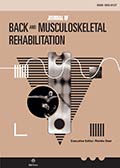Authors: Sia, Lee Lee | Sharma, Shobha | Ing, Janet Bong May | Kumar, Saravana | Singh, Devinder Kaur Ajit
Article Type:
Review Article
Abstract:
BACKGROUND: The growing use of telerehabilitation within the healthcare community has garnered substantial attention. In congruence with other healthcare fields, examining perceptions, barriers, and facilitators assumed paramount significance in the continuation and fortification of telerehabilitation practices among physiotherapists. OBJECTIVE: In this scoping review, we aimed to systematically map the literature on the perceptions of physiotherapists as well as the barriers and enablers of telerehabilitation in their daily practice. METHODS: The five-stage methodological framework recommended by Arksey and O’Malley (2005) was used for this scoping review. In the framework, eight databases were searched using
…key search terms such as “telerehabilitation”, “physiotherapists”, “readiness”, “enablers” and “barriers” All findings were organised into perceptions and readiness, enablers, and barriers. RESULTS: Fourteen articles met the inclusion criteria and were categorized as: (1) perception and readiness, (2) enablers, and (3) barriers. In the perception and readiness category, new trends in healthcare, advancement in physiotherapy practices and the benefits to clients were identified. The enablers identified included prior training, personal experience, familiarity with technology, functional equipment and space, and client selection. The barriers to the adoption of telerehabilitation in physiotherapy practice are pinpointed to poor technology, communication hurdles, limited availability, lack of familiarity, and client-related concerns. CONCLUSION: While initial evidence suggests a generally positive perceptions it is important to consider both facilitators and barriers when understanding adoption. This review’s findings revealed a wide research gap, with unequal weightage towards barriers compared to enablers, and highlights the need for further research. Developing telerehabilitation guidelines that cater to both physiotherapists and clients is necessary.
Show more
Keywords: Physiotherapists, telerehabilitation, perceptions, enablers, barriers
DOI: 10.3233/BMR-240009
Citation: Journal of Back and Musculoskeletal Rehabilitation,
vol. 37, no. 6, pp. 1441-1454, 2024
Price: EUR 27.50





